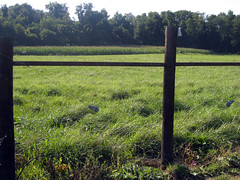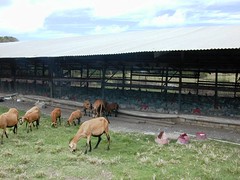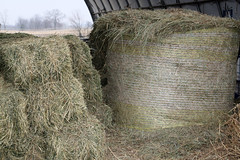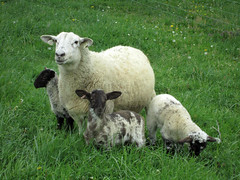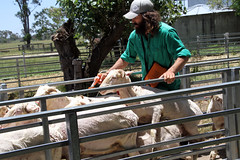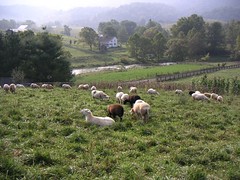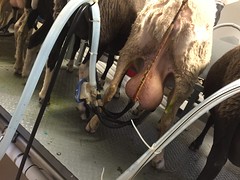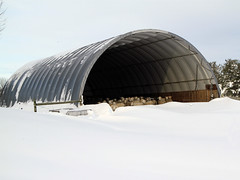- Sheep 201 Index
- Other web sites
In most agricultural enterprises, profit margins are slim and profitability varies from year to year, as supply and demand vacillate and input costs rise (and rarely fall). Sheep production is no different than any other agricultural enterprise. It is not a "get rich quick" scheme. It requires good animal husbandry and business management skills -- along with a little bit of luck -- to be successful and generate a consistent profit and return to land, labor, and capital.
Business planning
Business planning
A business plan is the foundation of a successful farming operation. It is a "road map." It allows you to plan your business before investing any of your own resources. It increases the chances for success and helps avoid costly mistakes. Business planning is considered essential to the success of both new and established enterprises. If a business isn't "profitable" on paper, it's not likely to be profitable in practice.
While the formats and components of business plans vary, most plans include an executive summary, business description, production plan, marketing plan, and financial plan. Not all plans include all of the same components or require as much detail. Business planning is usually more complicated for value-added enterprises versus production-only enterprises. It may be beneficial to separate the production side of the business from the processing and marketing of a value-added product, such as meat, dairy, or fiber products.
Cover sheet Name of business
Contact information
Date plan was preparedExecutive summary Business description
Mission statement
Goals
Plan summaryBusiness description Business overview
Location
Facilities
Business history
OwnershipProduction plan What will you produce?
How much will you produce?
How will you produce it?
Permits and regulationsMarketing plan Market trends
Marketing strategies
Marketing contracts
Marketing alliances
Competitive advantageFinancial plan Balance sheet
Income statement
Cash flow statement
Enterprise budgets
Most states and counties have numerous public agencies that can assist agricultural producers with business planning: Small Business Development Center, Farm Service Agency, and Cooperative Extension. Many county governments now have someone in the Economic Development Office that specializes in agriculture enterprises.
The University of Minnesota Center for Farm Financial Management has free online business planning software called AgPlan. In addition to completing your business plan online, you can view examples of business plans and share your plan with advisors.
Purdue University has an online business planner called INVenture. It uses a question and answer format to help you write a business plan. If you prefer to develop a business plan on paper, you can download business planning worksheets from the University of Maryland Rural Enterprise Development Center. There are numerous other web resources for business planning.
Key factors affecting profitability
Profitability is income minus expenses. In the short run, expenses can be limited to operating costs. In the long run, a successful business has to cover all its fixed costs. In agriculture, fixed costs are often called the "dirt-5": depreciation, interest, repairs, taxes, and insurance.
While many factors affect profitability of a sheep enterprise, the three key factors are feed costs, percent lamb crop, and market prices.
Feed costs
Feed costs, especially the cost of feeding the ewe flock, comprise the majority of costs in a sheep enterprise. It is not common for feed costs to comprise more than 70 percent of annual operating costs. Feed costs vary considerably geographically, from farm-to-farm, and from year to year. There are numerous strategies for reducing feed costs. No single feeding program is guaranteed to be more profitable. Some producers will be more profitable raising sheep predominately on forage diets, whereas others will be successful with considerable feeding of grain and/or by-products.
Read article Coping with high feed costs =>
Percent lamb crop
Percent lamb crop is defined as the number of (quality) lambs marketed (or retained for breeding) per ewe exposed for breeding. While there are some additional costs associated with producing a higher percentage lamb crop (e.g. lamb finishing costs), for the most part more lambs mean more profit. It generally costs the same amount of money to maintain a ewe no matter how many lambs she produces. Overhead or fixed costs are also reduced when productivity is higher.
The optimal size lamb crop varies by geographic location and production system. In situations where feed costs and overhead are very low and wool still comprises a significant portion of the income, a hundred percent lamb crop may be profitable, though a 125 percent lamb crop is probably feasible and more profitable.
For many sheep producers, a 200 percent lamb crop is an appropriate and obtainable goal. Most breeds of sheep are capable of producing a 200 percent lamb crop if they are fed and managed properly. In situations where land and production costs are higher, lamb crops in excess of 200 percent are realistic. To achieve such a lofty goal, accelerated lambing programs or prolific genetics are usually required. Despite the higher profit potential, it is not recommended that beginning shepherds start with prolific breeds or attempt to lamb ewes at frequent intervals.
There are various strategies for increasing lambing percentage. Not all strategies will likely be profitable on all farms. The number of lambs that a ewe gives birth to varies by her age, genetics, body condition, nutrition, and season. Ewes reach their peak productivity between the ages of 3 and 6. Maintaining too young of a flock will reduce lambing percentage, but should accelerate genetic improvement. In temperate climates, fertility is usually highest in the fall months when day length is shorter. Ewes bred to lamb in the spring (March-April) will usually give birth to more lambs than those bred to lamb in the winter or fall.
While the heritability of reproductive rate is low, only about 10 percent, selection will increase lambing percentage. The birth type of the individual lamb is less important than the lamb's family history for multiple births. It is especially important to select rams from families and/or flocks with a higher percentage of multiple births. Rams with large testicles are also desirable for breeding, as scrotal circumference has been linked to reproductive rate in female progeny.
Nutrition exerts a large effect on reproductive performance. Ewes that are in better body condition will usually ovulate more eggs. Flushing may increase the ovulation rates of ewes in sub-optimal body condition. It may also increase embryo survival. Flushing is when the nutrition is increased prior to and during the early part of the breeding season. It is usually accomplished by supplementing ewes with 1/2 to 1 lb. of grain per head per day or moving them to better quality pasture. Ewes that are already in good body condition usually do not respond to flushing.
Market prices
Obviously, higher (net) market prices will increase profitability. When evaluating marketing options, it is essential to compare "net" market prices. Higher prices aren't always more profitable, due to the increased costs associated with getting them.There are various ways to increase market prices. If lambs are marketed through public livestock auctions, there are various strategies for increasing returns.
Read Tips for marketing sheep (and goats) through public livestock auctions =>
The best prices for lambs are usually obtained when lambs are sold directly from the farm to commercial buyers, direct marketers, or consumers. You avoid paying the fees associated with sale barns, though you are still obligated to pay the lamb check-off. For on-farm sales, it's important to have a scale so you know what your lambs weigh. You also need to closely follow the local, regional, and national markets, so you know what your lambs are worth. Often, you can accept a lower price at the farm than you would expect at a sale barn, since your are incurring less selling costs. On the other hand, you should seek a premium for "farm-fresh" lambs.
If you sell directly to an abattoir, you may be able to establish a year-round or contract price. Larger abattoirs may be willing to pay for lambs according to a grid, which establishes a set of premiums and discounts. If you produce the kind of the lamb that the processor wants, you should be able to get a higher price for your lambs.
Marketing lambs, carcasses, and/or meat directly to consumers certainly has the potential to increase the value of lambs marketed. Adding value to milk and fiber also has the potential to increase the value of production.
<== SHEEP 201 INDEX
Copyright© 2021. Sheep 101 and 201.

